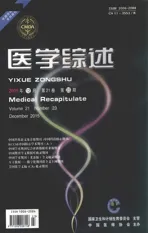TNF-α、PARP及施万细胞凋亡在糖尿病痛性周围神经病变中的作用
2015-02-09张雪利综述李全民审校
张雪利(综述),李全民(审校)
(1.山西医科大学第二临床医学院,太原 030000; 2.第二炮兵总医院内分泌科,北京 100088)
TNF-α、PARP及施万细胞凋亡在糖尿病痛性周围神经病变中的作用
张雪利1△(综述),李全民2※(审校)
(1.山西医科大学第二临床医学院,太原 030000; 2.第二炮兵总医院内分泌科,北京 100088)
摘要:糖尿病周围神经病变的发病机制复杂,为多种综合性因素参与。近年来,氧化应激导致的周围神经病变一直是大家关注的热点,而施万细胞凋亡导致的糖尿病周围神经病变研究甚少。肿瘤坏死因子α(TNF-α)及多聚腺苷二磷酸核糖合成酶(PARP)参与了血旺细胞凋亡的发生,均在糖尿病周围神经病变中发挥了重要作用。现就TNF-α、PARP与施万细胞凋亡的相关性及在糖尿病周围神经病变中的作用予以综述。
关键词:糖尿病周围神经病变;糖尿病痛性神经病变;肿瘤坏死因子α;多聚腺苷二磷酸核糖合成酶;施万细胞凋亡
目前糖尿病已成为一种发病率高且呈逐年上升的常见病,并迅速发展成为全球性常见病,它可累及心脏、肾脏、神经等,其中糖尿病痛性神经病变被认为是最常见的微血管并发症之一。施万细胞是周围神经系统特有的胶质细胞,能分泌神经营养因子,促进受损神经元的存活及其轴突的再生。一旦神经受损,它会分泌神经营养因子,营养和修复神经元和轴突。因此,推断施万细胞凋亡可能参与了糖尿病周围神经病变的发生。现有研究表明,施万细胞凋亡可使肿瘤坏死因子α(tumor necrosis factor-alpha,TNF-α)表达上升,而TNF-α作为一种促炎细胞因子在疼痛的产生与维持中起到了重要的作用[1],提示施万细胞凋亡可能是通过上调炎性细胞因子的表达参与了糖尿病痛性神经病变的发展。现对TNF-α、PARP及施万细胞凋亡在糖尿病痛性周围神经病变中的作用进行综述。
1TNF-α与施万细胞凋亡在糖尿病痛性神经病变中的作用
1.1TNF-α的结构及功能TNF-α主要由于T细胞、单核细胞、巨噬细胞等免疫细胞被激活而大量表达,并参与多种生物调节作用。TNF-α主要有两种细胞膜表面受体,分别是TNF-αⅠ型受体(TNFR-Ⅰ;p55)和TNF-αⅡ型受体(TNFR-Ⅱ;p75),其中TNFR-Ⅱ可对多种组织中的胰岛素信号通路发生作用,可能与糖尿病及相关并发症尤其是慢性并发症的发生、发展有关[2]。TNF-α作为一种炎性细胞因子,不仅在细胞免疫和炎症反应中发挥重要作用,同样也参与细胞增殖、分化和凋亡。TNF-α长期或高水平表达可导致炎症反应和凋亡的发生[3-5]。
1.2TNF-α及施万细胞凋亡与痛性神经病变细胞因子可通过与施万细胞相互作用在糖尿病周围神经病变的发展中发挥重要作用,而TNF-α作为突出的一个细胞因子可能参与其中。近几年随着研究的不断深入,逐渐认识到TNF-α确实参与了神经痛的发生、发展,但其具体机制尚不清楚。一方面,TNF-α可能通过对中枢神经系统的表观改变,导致中枢水平的β2肾上腺素能受体表达及功能发生变化,从而使中枢敏感化导致神经痛的发生;另一方面,TNF-α可能是以间接调节神经细胞合成的疼痛介质神经生长因子的方式参与了神经病理性疼痛的发生[6]。在一些糖尿病神经病变的试验中发现,TNF-α基因产物的表达上调[7]。目前,施万细胞对细胞因子的反应大多集中于受体水平的研究,而且施万细胞凋亡主要通过TNFR-Ⅰ 和p75TNFR两种分子机制发挥作用。Tanigawa等[8]通过免疫组织化学方法证实,施万细胞表面同时表达TNFR-Ⅰ 和p75TNFR,而主要在传导痛温觉信号发挥作用的中小神经元发现TNF-α受体的表达,且TNFR-Ⅱ、TNFR-Ⅰ主要表达在中小神经元上。Tsimokha等[9]研究发现,TNF-α培养施万细胞主要通过增加p75导致施万细胞凋亡,进一步研究还发现,TNF-α培养施万细胞使其剂量依赖性减少;且体内研究的证据明确p75调节施万细胞凋亡独立于Bcl-2蛋白,然而p75促发施万细胞凋亡依赖于许多细胞内外因子,这些因子主要对施万细胞的生存起作用。Jung等[10]通过对成人施万细胞的研究证明,外源性TNF-α培养施万细胞,可使施万细胞逆转至不成熟的表型,可通过表达p75TNFR评估,同时发现,这个通路的表达激活了前凋亡分子,即胱天蛋白酶(caspase)3。caspase-3是大家公认的早期细胞凋亡的一个生物学指标,主要参与细胞凋亡的形态学变化。以上资料直接表明,TNF-α可能通过逆转施万细胞的表型,使得施万细胞对凋亡易感,继而导致施万细胞凋亡。实验表明,神经疼痛情况下,在慢性缩窄性损伤大鼠的坐骨神经中,可检测到TNF-α瞬时上调[11-13]。TNF-α主要分布于巨噬细胞和施万细胞,同样,神经元发生华勒变性时,在局部损伤的神经元可发现TNFR-Ⅰ上调,类似的结果在人类中主要来自痛性神经病变神经活检时表现出高水平的TNF-α,尤其是在施万细胞中[14-16]。有研究报道,向坐骨神经内注射TNF-α的大鼠,可产生高敏性疼痛,类似于在人类中的神经痛[17]。此外,也有人用离体周围神经实验证实,在体外注射TNF-α可产生机械及热痛觉过敏,同时发现神经生长因子的表达上调,而神经生长因子是产生神经痛的一个公认的细胞因子;进一步TNFR-Ⅰ和p75TNFR剔除的小鼠研究发现,TNFR-Ⅰ表现为神经保护作用,而p75TNFR表现为神经毒性作用[18-19]。然而,关于TNFR-Ⅰ 和p75TNFR在慢性痛性神经病变中的相关作用仍存在争议。众所周知,caspase-3信号通路激活,可导致施万细胞凋亡,研究表明,应用caspase-3抑制剂治疗痛性神经病变可减轻外周神经痛[20],提示施万细胞凋亡可能参与了痛性神经病变的发生。
2多聚腺苷二磷酸核糖合成酶与施万细胞凋亡在糖尿病痛性神经病变中的作用
2.1多聚腺苷二磷酸核糖合成酶[poly(ADP-ribose)poly-merase,PARP]的结构与功能在生物细胞内存在着一系列修饰蛋白的物质,PARP家族充当了重要角色且成为近年关注的热点。PARP-1在真核细胞内大量表达,在整个PARP家族中其活性表达最高达90%,不仅在染色体稳定、DNA修复及细胞凋亡中发挥重要作用,也参与调控基因转录[21]。PARP-1主要通过两种方式发挥作用:一种是通过多聚腺苷二磷酸核糖化修饰促进基因转录,另一种则介导参与基因转录的增强子/启动子的组成发挥作用[22]。目前关于PARP-1对基因表达调控方面的研究是非常复杂的,因为它可与多种转录因子相互作用,同时也可通过不同转录因子间反向调节,甚至对同一种转录因子还可能发挥多重作用[23-26]。其机制可能与改变酶的作用进而使转录因子活性发生变化有关,另一方面,PARP-1也可不依赖其酶活性来发挥转录调节功能[27]。
2.2PARP与施万细胞凋亡病理条件下,DNA大量损伤,激活过多PARP,会耗尽烟酰胺腺嘌呤二核苷酸的储备、PARP的底物及大量腺苷三磷酸,最终导致细胞凋亡[28]。Lupachyk等[29]的实验表明,PARP的裂解提示施万细胞凋亡,因为在施万细胞凋亡的早期阶段,可发现Mr24 KD和Mr89 000片段的裂解,其具体作用过程可能是阻止了对DNA链的修复,从而导致细胞凋亡,提示对PARP片段进行检测,可能是施万细胞早期凋亡的一个可用性指标。Caspase-3活化被认为是细胞发生凋亡的一个公认的介导机制,因而,PARP也不可避免地需要通过激活caspase-3而促发施万细胞凋亡。但最近的研究表明,PARP过度激活可触发非caspase-3途径依赖的施万细胞凋亡机制,主要通过诱导线粒体释放凋亡诱导因子,引起细胞核DNA大量片段化及细胞凋亡的发生[30]。但令人失望的是,也有研究认为,PARP的活化和裂解与细胞凋亡均无因果关系,这可能是实验条件不同,得出的结果不一致[31],但大部分实验支持PARP的活化与施万细胞凋亡有关。
3PARP及TNF-α与痛性神经病变
TNF-α是体内一个重要的炎性因子,施万细胞是TNF-α的敏感靶点,TNF-α以时间依赖性的特点导致施万细胞凋亡。TNF-α培养施万细胞后,PARP活性在开始阶段呈现上升趋势,但随着细胞损伤时间延长,其活性可能被抑制。Velez等[32]研究表明,在TNF-α干预施万细胞后可导致DNA的破坏,进而启动PARP修复机制,在实验早期PARP活性持续增高,但随着时间的推移其活性逐渐降低。以上研究实验表明,施万细胞凋亡与TNF-α的表达上调及PARP活性相关。进一步实验表明,PARP-1的活性和表达水平与患者TNF-α的表达水平呈显著正相关,PARP抑制剂能够显著抑制核因子κB的激活和炎性细胞因子TNF-α的表达[32]。研究表明,PARP-1参与了核因子κB与DNA的结合[33-34]。由于PARP诱导细胞凋亡的机制并不单一,因此PARP活性下降可能有其他途径介导,具体机制有待进一步研究。PARP过度激活可修饰甘油醛-3-磷酸脱氢酶使其活性下降,继发下游4条经典途径,导致痛性神经病变的发生[35]。这从理论上支持PARP可通过上调INF的表达,引起糖尿病周围神经痛和感觉异常。Purwata等[36]发现,链脲佐菌素诱导成膜4周的糖尿病大鼠即存在热痛觉和机械痛觉过敏,如果在成膜2周后给予PARP抑制剂治疗2周,大鼠热痛阈和机械痛阈可得到改善。最新的实验报道,链脲佐菌素诱导的糖尿病大鼠,在12周时表现出明显的热痛觉、机械痛觉过敏及自发性疼痛,如果在成膜2周给予PARP抑制剂治疗10周,可部分改善痛觉过敏,减轻自发性疼痛[37]。这表明PARP过度活化诱导施万细胞凋亡最终导致了糖尿病痛性神经病变的发生,提示抑制PARP的活性,可能是预防或治疗痛性神经病变的一个新作用点。
4小结
TNF-α及PARP引起施万细胞凋亡可能是糖尿病痛性神经病变的一个原因,因此,了解施万细胞凋亡机制,并及时应用TNF抑制剂等进行临床干预,抑制施万细胞凋亡,可能是一个有效的新方法。虽不能使症状完全缓解,亦不可阻止糖尿病痛性神经病变的进展,但为进一步探讨糖尿病周围神经病变的发病机制提供了新的方向,并可深入了解糖尿病痛性神经病变的新靶点。
参考文献
[1]Leung L,Cahill CM.TNF-αand neuropathic pain-a review[J].J Neuroinflammation,2010,7:27.
[2]Tyan PI,Radwan AH,Eid A,etal.Novel approach to reactive oxygen species in nontransfusion-dependent thalassemia[J].Biomed Res Int,2014,2014:350432.
[3]Lee J,Lee J.Hypoxia-inducible Factor-1 (HIF-1)-independent hypoxia response of the small heat shock protein hsp-16.1 gene regulated by chromatin-remodeling factors in the nematode Caenorhabditis elegans[J].J Biol Chem,2013,288(3):1582-1589.
[4]Park JH,Seo JH,Wee HJ,etal.Nuclear translocation of hARD1 contributes to proper cell cycle progression[J].PLoS One,2014,9(8):e105185.
[5]Hanschmann EM,Godoy JR,Berndt C,etal.Thioredoxins,glutaredoxins,and peroxiredoxins--molecular mechanisms and health significance:from cofactors to antioxidants to redox signaling[J].Antioxid Redox Signal,2013,19(13):1539-1605.
[6]Yagihashi S,Mizukami H,Sugimoto K.Mechanism of diabetic neuropathy:Where are we now and where to go[J].J Diabetes Investig,2011,2(1):18-32.
[7]Andrade P,Veerle-Vandewalle V,Hoffmann C,etal.Role of TNF-alpha during central sensitization in preclinical studies[J].Neurol Sci,2011,32(5):757-771.
[8]Tanigawa K,Degang Y,Kawashima A,etal.Essential role of hormone-sensitive lipase (HSL) in the maintenance of lipid storage in Mycobacterium leprae-infected macrophages[J].Microb Pathog,2012,52(5):285-291.
[9]Tsimokha AS,Kulichkova VA,Karpova EV,etal.DNA damage modulates interactions between microRNAs and the 26S proteasome[J].Oncotarget,2014,5(11):3555-3567.
[10]Jung J,Cai W,Jang SY,etal.Transient lysosomal activation is essential for p75 nerve growth factor receptor expression in myelinated Schwann cells during Wallerian degeneration[J].Anat Cell Biol,2011,44(1):41-49.
[11]Dvoriantchikova G,Barakat D,Brambilla R,etal.Inactivation of astroglial NF-kappa B promotes survival of retinal neurons following ischemic injury[J].Eur J Neurosci,2009,30(2):175-185.
[12]Dubovy P.Wallerian degeneration and peripheral nerve conditions for both axonal regeneration and neuropathic pain induction[J].Ann Anat,2011,193(4):267-275.
[13]Gibbons CR,Liu S,Zhang Y,etal.Involvement of brain opioid receptors in the anti-allodynic effect of hyperbaric oxygen in rats with sciatic nerve crush-induced neuropathic pain[J].Brain Res,2013,1537:111-116.
[14]Sharma M,Deekshith V,Semwal A,etal.Discovery of Fused Triazolo-thiadiazoles as Inhibitors of TNF-alpha:Pharmacophore Hybridization for Treatment of Neuropathic Pain[J].Pain Ther,2012,1(1):3.
[15]Cummins EP,Berra E,Comerford KM,etal.Prolyl hydroxylase-1 negatively regulates IkappaB kinase-beta,giving insight into hypoxia-induced NFkappaB activity[J].Proc Natl Acad Sci U S A,2006,103(48):18154-18159.
[16]Gaudet AD,Popovich PG,Ramer MS.Wallerian degeneration:gaining perspective on inflammatory events after peripheral nerve injury[J].J Neuroinflammation,2011,8:110.
[17]Iwatsuki K,Arai T,Ota H,etal.Targeting anti-inflammatory treatment can ameliorate injury-induced neuropathic pain[J].PLoS One,2013,8(2):e57721.
[18]Dubovy P,Jancalek R,Kubek T.Role of inflammation and cytokines in peripheral nerve regeneration[J].Int Rev Neurobiol,2013,108:173-206.
[19]Kim JK,Lee HJ,Park HT.Two faces of Schwann cell dedifferentiation in peripheral neurodegenerative diseases:pro-demyelinating and axon-preservative functions[J].Neural Regen Res,2014,9(22):1952-1954.
[20]Ogawa N,Kawai H,Terashima T,etal.Gene therapy for neuropathic pain by silencing of TNF-α expression with lentiviral vectors targeting the dorsal root ganglion in mice[J].PLoS One,2014,9(3):e92073.
[21]Langelier MF,Riccio AA,Pascal JM,etal.PARP-2 and PARP-3 are selectively activated by 5′ phosphorylated DNA breaks through an allosteric regulatory mechanism shared with PARP-1[J].Nucleic Acids Res,2014,42(12):7762-7775.
[22]Leung L,Cahill CM.TNF-alpha and neuropathic pain--a review[J].J Neuroinflammation,2010,7:27.
[23]Voigt S,Philipp S,Davarnia P,etal.TRAIL-induced programmed necrosis as a novel approach to eliminate tumor cells[J].BMC Cancer,2014,14:74.
[24]Parameswaran N,Patial S.Tumor necrosis factor-α signaling in macrophages[J].Crit Rev Eukaryot Gene Expr,2010,20(2):87-103.
[25]Zhang L,Berta T,Xu ZZ,etal.TNF-α contributes to spinal cord synaptic plasticity and inflammatory pain:distinct role of TNF receptor subtypes 1 and 2[J].Pain,2011,152(2):419-427.
[26]Ji Y,Tulin AV.Post-transcriptional regulation by poly(ADP-ribosyl)ation of the RNA-binding proteins[J].Int J Mol Sci,2013,14(8):16168-16183.
[27]Fouquerel E,Goellner EM,Yu Z,etal.ARTD1/PARP1 negatively regulates glycolysis by inhibiting hexokinase 1 independent of NAD+ depletion[J].Cell Rep,2014,8(6):1819-1831.
[28]Ko HL,Ren EC.Functional Aspects of PARP1 in DNA Repair and Transcription[J].Biomolecules,2012,2(4):524-548.
[29]Lupachyk S,Shevalye H,Maksimchyk Y,etal.PARP inhibition alleviates diabetes-induced systemic oxidative stress and neural tissue 4-hydroxynonenal adduct accumulation:correlation with peripheral nerve function[J].Free Radic Biol Med,2011,50(10):1400-1409.
[30]Castri P,Lee YJ,Ponzio T,etal.Poly(ADP-ribose) polymerase-1 and its cleavage products differentially modulate cellular protection through NF-kB-dependent signaling[J].Biochim Biophys Acta,2014,1843(3):640-651.
[31]Yang DP,Kim J,Syed N,etal.p38 MAPK activation promotes denervated Schwann cell phenotype and functions as a negative regulator of Schwann cell differentiation and myelination[J].J Neurosci,2012,32(21):7158-7168.
[32]Velez J,Hail N Jr,Konopleva M,etal.Mitochondrial uncoupling and the reprograming of intermediary metabolism in leukemia cells[J].Front Oncol,2013,3:67.
[33]Pion P,Vouldoukis I,Dukas N,etal.Redox-dependent apoptosis in human endothelial cells after adhesion of Plasmodium falciform-infected erythrocytes[J].Ann N Y Acad Sci,2003,1010:582-
586.
[34]Empl M,Renaud S,Erne B,etal.TNF-alpha expression in painful and non-painful neuropathies[J].Neurology,2001,56(10):1371-
1377.
[35]Morton PD,Johnstone JT,RamosAY,etal.Nuclear factor-κB activation in schwann cells regulates regeneration and remyelination[J].Glia,2012,60(4):639-650.
[36]Purwata TE.High TNF-alpha plasma levels and macrophages iNOS and TNF-alpha expression as risk factors for painful diabetic neuropathy[J].J Pain Res,2011,4:169-175.
[37]Ta LE,Schemlzer JD,Bieber AJ,etal.A novel and selective poly (ADP-ribose) polymerase inhibitor ameliorates chemotherapy-induced painful neuropathy[J].PLoS One,2013,8(1):e54161.
The Effect of TNF-α,PARP and Schwann Cell Apoptosis in Diabetic Painful Neuropathy
ZHANGXue-li1,LIQuan-min2.
(1.ShanxiMedicalUniversityoftheSecondClinicalMedicalCollege,Taiyuan030000,China; 2.DepartmentofEndocrinology,theSecondArtilleryGeneralHospitalofPeople′sLiberationArmy,Beijing100088,China)
Abstract:The pathogenesis of diabetic peripheral neuropathy is complex,which involves a variety of factors.In recent years,oxidative stress caused peripheral neuropathy has been the focus of attention,but the research on Schwann cells apoptosis resulted peripheral neuropathy in diabetes is rarely seen.Tumor necrosis factor α(TNF-α) and poly(ADP-ribose)polymerase(PARP) are involved in the pathogenesis of Schwann cell apoptosis,playing an important role in diabetic peripheral neuropathy.Here is to make a review of the correlation between TNF-α,PARP and Schwann cell apoptosis in diabetic peripheral neuropathy.
Key words:Diabetic peripheral neuropathy; Diabetic painful neuropathy; Tumor necrosis factor-α; Poly(ADP-ribose)polymerase; Schwann cell apoptosis
收稿日期:2015-02-26修回日期:2015-04-13编辑:郑雪
doi:10.3969/j.issn.1006-2084.2015.23.034
中图分类号:R58
文献标识码:A
文章编号:1006-2084(2015)23-4317-03
